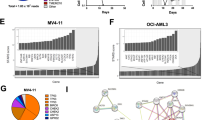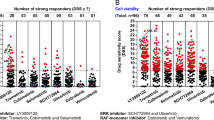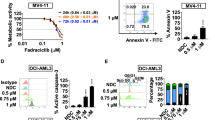Abstract
Drug resistance remains a serious limiting factor in the treatment of acute myeloid leukaemia (AML) either at initial presentation or following primary or subsequent relapses. Using specific kinase inhibitors, this study has investigated the contribution of the Ras/PI3-kinase regulated survival pathways to drug resistance and suppression of apoptosis in a cell line derived from AML (HL60). Inhibition of the Raf/MAP-kinase (ERK) pathway with a specific MAP-kinase inhibitor, apigenin did not sensitise HL60 cells to drug-induced apoptosis, indicating a lack of involvement in chemoresistance. In contrast, the PI3-kinase inhibitors, LY294002 and wortmannin, did induce a significant increase in apoptosis in combination with cytotoxic drugs. The contribution of downstream mediators of PI3-kinase, p70S6-kinase and PKB/Akt were then investigated. While inhibition of p70S6-kinase with rapamycin did not increase drug-induced apoptosis, PI3-kinase inhibition resulted in notable dephosphorylation of PKB, suggesting that the PI3-kinase/PKB survival pathway may play a major role in chemoresistance in AML. This pathway has been reported to mediate heterodimer interactions with the proapoptotic regulator, Bad. In contrast to previous studies, we found no evidence of Bad binding to anti-apoptotic Bcl-2, Bcl-XLor Mcl-1, or of alterations in Bax heterodimers. This suggests that alternative targets of PI3-kinase/PKB, distinct from the Bcl-2 family may be responsible for contributing to survival factor-mediated drug resistance in AML.
This is a preview of subscription content, access via your institution
Access options
Subscribe to this journal
Receive 12 print issues and online access
$259.00 per year
only $21.58 per issue
Buy this article
- Purchase on Springer Link
- Instant access to full article PDF
Prices may be subject to local taxes which are calculated during checkout







Similar content being viewed by others
References
Ashkenazi A, Dixit VM . Death receptors: signaling and modulation Science 1998 281: 1305–1308
O'Connor R . Survival factors and apoptosis. In: Scheper T (ed) Advances in Biochemical Engineering/Biotechnology vol. 62: Springer-Verlag: Heidelberg 1998 pp 137–166
Senent L, Jarque I, Martin G, Sempere A, Gonzalez-Garcia Y, Gomis F, Perez-Sirvent M, De La Rubia J, Sanz MA . P-glycoprotein expression and prognostic value in acute myeloid leukemia Haematologica 1998 83: 783–787
Legrand O, Zittoun R, Marie JP . Role of MRP1 in multidrug resistance in acute myeloid leukemia Leukemia 1999 13: 578–584
Massaad-Massade L, Ribrag V, Marie JP, Faussat AM, Bayle C, Dreyfus F, Gouyette A . Glutathione system, topoisomerase II level and multidrug resistance phenotype in acute myelogenous leukemia before treatment and at relapse Anticancer Res 1997 17: 4647–4651
McKenna SL, Padua RA . Multidrug resistance in leukaemia Br J Haematol 1997 96: 659–674
Downward J . Ras signalling and apoptosis Curr Opin Genet Dev 1998 8: 49–54
Joneson T, Bar-Sagi D . Ras effectors and their role in mitogenesis and oncogenesis J Mol Med 1997 75: 587–593
Rommel C, Hafen E . Ras – a versatile cellular switch Curr Opin Genet Dev 1998 8: 412–418
McCormick F . Signal transduction. How receptors turn Ras on Nature 1993 363: 15–16
Vojtek AB, Der CJ . Increasing complexity of the Ras signaling pathway J Biol Chem 1998 273: 19925–19928
Quilliam LA, Khosravi-Far R, Huff SY, Der CJ . Guanine nucleotide exchange factors: activators of the Ras superfamily of proteins Bioessays 1995 17: 395–404
Wittinghofer A, Scheffzek K, Ahmadian MR . The interaction of Ras with GTPase-activating proteins FEBS Lett 1997 410: 63–67
Bos JL . Ras oncogenes in human cancer: a review Cancer Res 1989 49: 4682–4689
Byrne JL, Marshall CJ . The molecular pathophysiology of myeloid leukaemias: Ras revisited Br J Haematol 1998 100: 256–264
Friess H, Berberat P, Schilling M, Kunz J, Korc M, Buchler MW . Pancreatic cancer: the potential clinical relevance of alterations in growth factors and their receptors J Mol Med 1996 74: 35–42
Demetri GD, Ernst TJ, Pratt ESD, Zenzie BW, Rheinwald JG, Griffin JD . Expression of ras oncogenes in cultured human cells alters the transcriptional and posttranscriptional regulation of cytokine genes J Clin Invest 1990 86: 1261–1269
Gougopoulou DM, Kiaris H, Ergazaki M, Anagnostopoulos NI, Grigoraki V, Spandidos DA . Mutations and expression of the ras family genes in leukemias Stem Cells 1996 14: 725–729
Price CM, Marshall CJ, Bashey A . Sequential acquisition of trisomy 8 and N-ras mutation in acute myeloid leukaemia demonstrated by analysis of isolated leukaemic colonies Br J Haematol 1994 88: 338–342
Weijzen S, Velders MP, Kast WM . Modulation of the immune response and tumor growth by activated Ras Leukemia 1999 13: 502–513
Kinoshita T, Yokota T, Arai K, Miyajima A . Regulation of Bcl-2 expression by oncogenic Ras protein in hematopoietic cells Oncogene 1995 10: 2207–2212
Bensi L, Longo R, Vecchi A, Messora C, Garagnani L, Bernardi S, Tamassia MG, Sacchi S . Bcl-2 oncoprotein expression in acute myeloid leukemia Haematologica 1995 80: 98–102
Karakas T, Maurer U, Weidmann E, Miething CC, Hoelzer D, Bergmann L . High expression of bcl-2 mRNA as a determinant of poor prognosis in acute myeloid leukemia Ann Oncol 1998 9: 159–165
Kinoshita T, Yokota T, Arai K, Miyajima A . Suppression of apoptotic death in hematopoietic cells by signalling through the IL-3/GM-CSF receptors EMBO J 1995 14: 266–275
Minshall C, Arkins S, Freund GG, Kelley KW . requirement for phosphatidylinositol 3′-kinase to protect hemopoietic progenitors against apoptosis depends upon the extracellular survival factor J Immunol 1996 156: 939–947
Scheid MP, Lauener RW, Duronio V . Role of phosphatidylinositol 3-OH-kinase activity in the inhibition of apoptosis in haemopoietic cells: phosphatidylinositol 3-OH-kinase inhibitors reveal a difference in signalling between interleukin-3 and granulocyte–macrophage colony stimulating factor Biochem J 1995 312: 159–162
Franke TF, Kaplan DR, Cantley LC . PI3K: downstream AKTion blocks apoptosis Cell 1997 88: 435–437
Gajewski, TF, Thompson CB . Apoptosis meets signal transduction: elimination of a BAD influence Cell 1996 87: 589–592
Downward J . Mechanisms and consequences of activation of protein kinase B/Akt Curr Opin Cell Biol 1998 10: 262–267
Cleveland JL, Troppmair J, Packham G, Askew DS, Lloyd P, Gonzalez-Garcia M, Nunez G, Ihle JN, Rapp UR . v-raf suppresses apoptosis and promotes growth of interleukin-3-dependent myeloid cells Oncogene 1994 9: 2217–2226
Wang HG, Miyashita T, Takayama S, Sato T, Torigoe T, Krajewski S, Tanaka S, Hovey Lr, Troppmair J, Rapp UR, Reed J . Apoptosis regulation by interaction of Bcl-2 protein and Raf-1 kinase Oncogene 1994 9: 2751–2756
Xia Z, Dickens M, Raingeaud J, Davis RJ, Greenberg ME . Opposing effects of ERK and JNK-p38 MAP kinases on apoptosis Science 1995 270: 1326–1331
Rodriguez-Viciana P, Warne PH, Dhand R, Vanhaesebroeck B, Gout I, Fry MJ, Waterfield MD, Downward J . Phosphatidylinositol-3-OH kinase as a direct target of Ras Nature 1994 370: 527–532
Kodaki T, Woscholski R, Hallberg B, Rodriguez-Viciana P, Downward J, Parker PJ . The activation of phosphatidylinositol 3-kinase by Ras Curr Biol 1994 4: 798–806
Kinoshita T, Shirouzu M, Kamiya A, Hashimoto K, Yokoyama S, Miyajima A . Raf/MAPK and rapamycin-sensitive pathways mediate the anti-apoptotic function of p21Ras in IL-3-dependent hematopoietic cells Oncogene 1997 15: 619–627
Chou MM, Blenis J . The 70kDa S6 kinase: regulation of a kinase with multiple roles in mitogenic signalling Curr Opin Cell Biol 1995 7: 806–814
Collard JG, van Beek WP, Janssen JW, Schijven JF . Transfection by human oncogenes: concomitant induction of tumorigenicity and tumor-associated membrane alterations Int J Cancer 1985 35: 207–213
Hall A, Marshall CJ, Spurr NK, Weiss RA . Identification of transforming gene in two human sarcoma cell lines as a new member of the ras gene family located on chromosome 1 Nature 1983 303: 396–400
Gallagher R, Collins S, Trujillo J, McCredie K, Ahearn M, Tsai S, Metzgar R, Aulakh G, Ting R, Ruscetti F, Gallo R . Characterization of the continuous, differentiating myeloid cell line (HL-60) from a patient with acute promyelocytic leukemia Blood 1979 54: 713–733
Gorman A, McCarthy J, Finucane D, Reville W, Cotter TG . Morphological assessment of apoptosis. In: Cotter TG, Martin SJ (eds) Techniques in Apoptosis, A User's Guide Portland Press: London 1996 pp 1–20
Darzynkiewicz Z, Li X . Measurements of cell death by flow cytometry. In: Cotter TG, Martin SJ (eds) Techniques in Apoptosis, A User's Guide Portland Press: London 1996 pp 71–106
D'Arpa P, Liu LF . Topoisomerase-targeting antitumor drugs Biochim Biophys Acta 1989 989: 163–177
Whitman M, Kaplan DR, Schaffhausen B, Cantley L, Roberts TM . Association of phosphatidylinositol kinase activity with polyoma middle-T competent for transformation Nature 1985 315: 239–242
Hoffbrand AV, Pettit JE . Acute Leukaemias: Essential Haematology 3rd edn: Blackwell Scientific Publications: Oxford 1993 pp 209–231
Howard MR, Hamilton PJ . Haematology Churchill Livingstone: Edinburgh 1999
Kuo ML, Yang NC . Reversion of v-H-ras-transformed NIH 3T3 cells by apigenin through inhibiting mitogen activated protein kinase and its downstream oncogenes Biochem Biophys Res Commun 1995 212: 767–775
Dudek H, Datta SR, Franke TF, Birnbaum MJ, Yao R, Cooper GM, Segal RA, Kaplan DR, Greenberg ME . Regulation of neuronal survival by the serine-threonine protein kinase Akt Science 1997 275: 661–665
Kennedy SG, Wagner AJ, Conzen SD, Jordan J, Bellacosa A, Tsichlis PN, Hay N . The PI 3-kinase/Akt signaling pathway delivers an anti-apoptotic signal Genes Dev 1997 11: 701–713
Vlahos CJ, Matter WF, Hui KY, Brown RF . A specific inhibitor of phosphatidylinositol 3-kinase, 2-(4-morpholinyl)-8-phenyl-4H-1-benzopyran-4-one (LY294002) J Biol Chem 1994 269: 5241–5248
Ui M, Okada T, Hazeki K, Hazeki O . Wortmannin as a unique probe for an intracellular signalling protein, phosphoinositide 3-kinase Trends Biochem Sci 1995 20: 303–307
Duronio V, Scheid MP, Ettinger S . Downstream signalling events regulated by phosphatidylinositol 3-kinase activity Cell Signal 1998 10: 233–239
Ferrari S, Pearson RB, Siegmann M, Kozma SC, Thomas G . The immunosuppressant rapamycin induces inactivation of p70s6k through dephosphorylation of a novel set of sites J Biol Chem 1993 268: 16091–16094
Franke TF, Cantley LC . Apoptosis. A Bad kinase makes good Nature 1997 390: 116–117
Yang E, Zha J, Jockel J, Boise LH, Thompson CB, Korsmeyer SJ . Bad, a heterodimeric partner for Bcl-XL and Bcl-2, displaces Bax and promotes cell death Cell 1995 80: 285–291
Chao JR, Wang JM, Lee SF, Peng HW, Lin YH, Chou CH, Li JC, Huang HM, Chou CK, Kuo ML, Yen JJ, Yang-Yen HF . mcl-1 is an immediate–early gene activated by the granulocyte–macrophage colony-stimulating factor (GM-CSF) signaling pathway and is one component of the GM-CSF viability response Mol Cell Biol 1998 18: 4883–4898
Zhou P, Qian L, Kozopas KM, Craig RW . Mcl-1, a Bcl-2 family member, delays the death of hematopoietic cells under a variety of apoptosis-inducing conditions Blood 1997 89: 630–643
Kaufmann SH, Karp JE, Svingen PA, Krajewski S, Burke PJ, Gore SD, Reed JC . Elevated expression of the apoptotic regulator Mcl-1 at the time of leukemic relapse Blood 1998 91: 991–1000
Otter I, Conus S, Ravn U, Rager M, Olivier R, Monney L, Fabbro D, Borner C . The binding properties and biological activities of Bcl-2 and Bax in cells exposed to apoptotic stimuli J Biol Chem 1998 273: 6110–6120
Hsu YT, Youle RJ . Bax in murine thymus is a soluble monomeric protein that displays differential detergent-induced conformations J Biol Chem 1998 273: 10777–10783
Oltvai ZN, Milliman CL, Korsmeyer SJ . Bcl-2 heterodimerizes in vivo with a conserved homolog, Bax, that accelerates programmed cell death Cell 1993 74: 609–619
Sedlak TW, Oltvai ZN, Yang E, Wang K, Boise LH, Thompson CB, Korsmeyer SJ . Multiple Bcl-2 family members demonstrate selective dimerizations with Bax Proc Natl Acad Sci USA 1995 92: 7834–7838
Hinton HJ, Welham MJ . Cytokine-induced protein kinase B activation and bad phosphorylation do not correlate with cell survival of hemopoietic cells J Immunol 1999 162: 7002–7009
Scheid MP, Duronio V . Dissociation of cytokine-induced phosphorylation of Bad and activation of PKB/akt: involvement of MEK upstream of Bad phosphorylation Proc Natl Acad Sci USA 1998 95: 7439–7444
Kitada S, Krajewska M, Zhang X, Scudiero D, Zapata JM, Wang HG, Shabaik A, Tudor G, Krajewski S, Myers TG, Johnson GS, Sausville EA, Reed JC . Expression and location of pro-apoptotic Bcl-2 family protein BAD in normal human tissues and tumor cell lines Am J Pathol 1998 152: 51–61
Minn AJ, Kettlun CS, Liang H, Kelekar A, Vander Heiden MG, Chang BS, Fesik SW, Fill M, Thompson CB . Bcl-xL regulates apoptosis by heterodimerization-dependent and -independent mechanisms EMBO J 1999 18: 632–643
Holmgreen SP, Huang DC, Adams JM, Cory S . Survival activity of Bcl-2 homologs Bcl-w and A1 only partially correlates with their ability to bind pro-apoptotic family members Cell Death Differ 1999 6: 525–532
Ito T, Deng X, Carr B, May WS . Bcl-2 phosphorylation required for anti-apoptosis function J Biol Chem 1997 272: 11671–11673
May WS, Tyler PG, Ito T, Armstrong DK, Qatsha KA, Davidson NE . Interleukin-3 and bryostatin-1 mediate hyperphosphorylation of BCL2 alpha in association with suppression of apoptosis J Biol Chem 1994 269: 26865–26870
Minshall C, Arkins S, Straza J, Conners J, Dantzer R, Freund GG, Kelley KW . IL-4 and insulin-like growth factor-I inhibit the decline in Bcl-2 and promote the survival of IL-3-deprived myeloid progenitors J Immunol 1997 159: 1225–1232
Hu Y, Benedict MA, Wu D, Inohara N, Nunez G . Bcl-XL interacts with Apaf-1 and inhibits Apaf-1-dependent caspase-9 activation Proc Natl Acad Sci USA 1998 95: 4386–4391
Cardone MH, Roy N, Stennicke HR, Salvesen GS, Franke TF, Stanbridge E, Frisch S, Reed JC . Regulation of cell death protease caspase-9 by phosphorylation Science 1998 282: 1318–1321
Brunet A, Bonni A, Zigmond MJ, Lin MZ, Juo P, Hu LS, Anderson MJ, Arden KC, Blenis J, Greenberg ME . Akt promotes cell survival by phosphorylating and inhibiting a Forkhead transcription factor Cell 1999 96: 857–868
Widmann C, Gibson S, Johnson GL . Caspase-dependent cleavage of signaling proteins during apoptosis. A turn-off mechanism for anti-apoptotic signals J Biol Chem 1998 273: 7141–7147
Plo I, Bettaieb A, Payrastre B, Mansat-De Mas V, Bordier C, Rousse A, Kowalski-Chauvel A, Laurent G, Lautier D . The phosphoinositide 3-kinase/Akt pathway is activated by daunorubicin in human acute myeloid leukemia cell lines FEBS Lett 1999 452: 150–154
Bataille R, Barlogie B, Lu ZY, Rossi JF, Lavabre-Bertrand T, Beck T, Wijdenes J, Brochier J, Klein B . Biologic effects of anti-interleukin-6 murine monoclonal antibody in advanced multiple myeloma Blood 1995 86: 685–691
Acknowledgements
This work was supported by grants from The Irish Cancer Society, Ireland; Fobairt, Ireland and the Childrens Leukaemia Research Project, Ireland. The authors are grateful to Drs Rosemary O'Connor, Emma Creagh and Adam Curnock for their assistance and valuable discussions.
Author information
Authors and Affiliations
Rights and permissions
About this article
Cite this article
O'Gorman, D., McKenna, S., McGahon, A. et al. Sensitisation of HL60 human leukaemic cells to cytotoxic drug-induced apoptosis by inhibition of PI3-kinase survival signals. Leukemia 14, 602–611 (2000). https://doi.org/10.1038/sj.leu.2401726
Received:
Accepted:
Published:
Issue Date:
DOI: https://doi.org/10.1038/sj.leu.2401726
Keywords
This article is cited by
-
Inhibition of PI3K Signaling Intensified the Antileukemic Effects of Pioglitazone: New Insight into the Application of PPARγ Stimulators in Acute Lymphoblastic Leukemia
Indian Journal of Hematology and Blood Transfusion (2023)
-
Targeting HDAC3, a new partner protein of AKT in the reversal of chemoresistance in acute myeloid leukemia via DNA damage response
Leukemia (2017)
-
Role of a novel benzoxazine derivative in the chemosensitization of colon cancer
Apoptosis (2017)
-
MK-2206 induces apoptosis of AML cells and enhances the cytotoxicity of cytarabine
Medical Oncology (2015)
-
Chemical genomic screening identifies LY294002 as a modulator of glucocorticoid resistance in MLL-rearranged infant ALL
Leukemia (2014)



